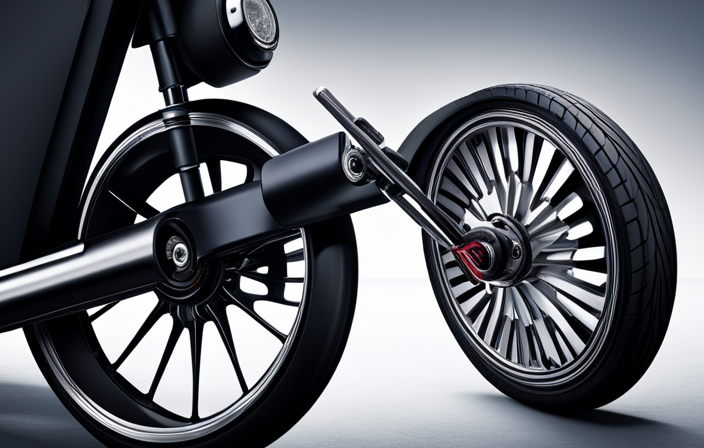Did you know that the average electric bike charge can last up to 50 miles on a single charge? That’s enough to commute to work, run errands, and explore the city without worrying about running out of power.
In this article, I will delve into the factors that affect electric bike battery life, provide tips to extend its longevity, and discuss the future of electric bike battery technology.
So, if you’re curious about how long your electric bike charge can last, keep reading to find out more.
Key Takeaways
- Battery efficiency has greatly improved in recent years, allowing electric bike charges to last longer.
- Lithium-ion and lithium iron phosphate batteries offer higher energy density and charge cycles, resulting in longer-lasting charges.
- Regularly charging the battery and properly maintaining it can help maintain capacity and performance, ensuring a longer-lasting charge.
- Investing in a high-quality electric bike battery can also contribute to a longer-lasting charge.
Understanding Electric Bike Batteries
You’ll need to understand electric bike batteries and how long their charge can last. Electric bike battery maintenance is an essential aspect of owning an electric bike. To ensure your battery lasts as long as possible, it’s vital to understand battery capacity.
Battery capacity refers to the amount of energy a battery can store, usually measured in watt-hours (Wh). The higher the battery capacity, the longer your electric bike will run on a single charge. It’s important to note that battery capacity can vary depending on factors such as battery age, temperature, and usage.
In the next section, we will discuss the factors affecting electric bike battery life. Understanding these factors will help you make the most of your electric bike’s battery and prolong its overall lifespan.
Factors Affecting Electric Bike Battery Life
One of the factors that affects the battery life of an electric bike is the way it is used and maintained. Several factors can impact the charging efficiency of an electric bike battery.
First and foremost, the battery capacity plays a crucial role in determining the range of the bike. A higher capacity battery can provide a longer range, whereas a lower capacity battery may require more frequent charging.
Additionally, the type of terrain and riding conditions can affect the battery life. Riding uphill or in extreme temperatures can put more strain on the battery, resulting in a shorter charge.
Proper maintenance, such as regular cleaning and keeping the battery at an optimal temperature, can also contribute to extending the battery life.
Understanding these factors will help maximize the efficiency and lifespan of an electric bike battery.
Transitioning into the subsequent section about tips to extend electric bike battery life, it is important to implement these practices to get the most out of your electric bike.
Tips to Extend Electric Bike Battery Life
To maximize the lifespan of your e-bike battery, it’s essential to follow these tips for extending battery life and maintaining battery efficiency.
| Tip | Explanation |
|---|---|
| Avoid extreme temperatures | Extreme heat or cold can damage the battery, so store it properly. |
| Charge the battery correctly | Follow the manufacturer’s instructions for the charging process. |
| Regularly clean and inspect the battery | Keep the battery clean and free from debris to prevent damage. |
| Use the correct charger | Using the wrong charger can harm the battery’s performance. |
| Avoid overcharging | Overcharging can shorten the battery’s lifespan, so be cautious. |
By implementing these tips, you can ensure that your electric bike battery lasts longer and maintains its efficiency. Following these guidelines will help you get the most out of your e-bike rides. Now let’s move on to the next section and explore the average range of electric bike charges.
Average Range of Electric Bike Charges
The average range of charges for an e-bike can vary depending on factors such as battery capacity and terrain. Electric bike battery capacity plays a significant role in determining how far you can go on a single charge. Typically, e-bike batteries have a capacity ranging from 300Wh to 700Wh. A higher capacity battery will provide a longer range.
However, it’s important to note that other factors can also affect the electric bike’s range. Terrain, for example, can impact how far you can ride on a single charge. Riding uphill or on rough terrain will consume more battery power compared to riding on flat roads. Additionally, factors like wind resistance, rider weight, and level of assistance also influence electric bike range.
Transitioning into the next section, the charging time for electric bike batteries is another crucial aspect to consider.
Charging Time for Electric Bike Batteries
When charging your e-bike battery, you’ll want to consider the amount of time it takes to reach a full charge. The charging time for electric bike batteries can vary depending on the type of battery and the charging method used. Some electric bike charging stations offer faster charging times compared to others. Additionally, advancements in technology have introduced solar-powered electric bike charging stations, which utilize renewable energy to charge your battery. These stations can be a convenient and environmentally friendly option for e-bike owners. To give you an idea of charging times, here’s a table that compares the average charging times for different types of electric bike batteries:
| Battery Type | Charging Time |
|---|---|
| Lithium-ion | 2-6 hours |
| Lead-acid | 6-8 hours |
| Nickel-cadmium | 4-6 hours |
By understanding the charging times for electric bike batteries, you can plan your charging routine accordingly and ensure your battery is ready for your next ride. Maximizing the longevity of electric bike batteries is crucial, and the next section will provide valuable tips on how to achieve that.
Maximizing Longevity of Electric Bike Batteries
When it comes to maximizing the longevity of electric bike batteries, there are a few key points to consider.
First, proper battery storage and temperature control are crucial. It’s important to store the batteries in a cool, dry place and avoid extreme temperatures.
Secondly, avoiding deep discharges can significantly extend the lifespan of the batteries. It’s best to recharge the batteries before they are completely drained.
Lastly, when the time comes to replace the batteries, it’s important to recycle them properly to minimize environmental impact.
Battery Storage and Temperature
Battery storage and temperature can have a significant impact on the longevity of electric bike charges. Proper battery maintenance is essential to ensure optimal performance and lifespan. One crucial factor to consider is the impact of temperature. Extreme heat or cold can shorten the battery’s life and reduce its overall capacity. To illustrate this, let’s examine the following table:
| Temperature (°C) | Battery Lifespan |
|---|---|
| Below 0 | Decreased |
| 0-25 | Optimal |
| Above 25 | Decreased |
As shown in the table, temperatures below freezing or above 25°C can lead to a decrease in battery lifespan. It is important to store your electric bike in a cool, dry place to avoid exposing it to extreme temperatures. By taking these precautions, you can maximize the lifespan of your electric bike battery and avoid deep discharges.
Avoiding Deep Discharges
To maximize the lifespan of your e-bike battery, make sure to avoid deep discharges. Preventing discharge is crucial in prolonging battery life. Here are some tips to help you achieve this:
-
Regular charging: Charge your e-bike battery after every use, even if it’s only partially depleted. This helps prevent the battery from dropping to low levels, which can cause deep discharges.
-
Avoid extreme temperatures: Extreme heat or cold can negatively impact battery performance. Store your e-bike battery in a cool, dry place to maintain optimal conditions.
-
Use power modes wisely: Adjust your e-bike’s power modes according to your needs. Higher power modes consume more battery power, so using them sparingly can help avoid deep discharges.
By following these guidelines, you can prolong the life of your e-bike battery.
When it’s time to replace or recycle your battery, there are proper steps to ensure environmental responsibility.
Replacing and Recycling Batteries
Now that we have discussed the importance of avoiding deep discharges in electric bike batteries, let’s move on to the topic of replacing and recycling batteries.
When it comes to electric bike batteries, there will eventually come a time when they need to be replaced. However, it is crucial to dispose of them properly to minimize their environmental impact. Battery disposal should be done in accordance with local regulations and guidelines to ensure that they are recycled or disposed of in an eco-friendly manner.
Additionally, it is worth considering eco-friendly battery options when replacing your electric bike battery. These options include batteries with longer lifespans, improved energy efficiency, and recyclable materials. By choosing eco-friendly battery options, we can reduce our carbon footprint and contribute to a more sustainable future.
Now, let’s debunk some common myths and misconceptions about electric bike batteries.
Common Myths and Misconceptions about Electric Bike Batteries
Don’t believe the common myths and misconceptions about how long your electric bike charge lasts. Contrary to popular belief, electric bike batteries can last for a considerable amount of time if properly maintained. Here are some battery maintenance tips to ensure optimal performance:
- Regularly charge your battery to prevent deep discharges.
- Avoid exposing your battery to extreme temperatures.
- Store your battery in a cool and dry place when not in use.
- Clean the battery contacts regularly to ensure a good connection.
- Follow the manufacturer’s instructions for charging and storing your battery.
By following these battery maintenance tips, you can maximize the lifespan of your electric bike battery and enjoy longer rides.
Now, let’s explore how electric bike batteries compare to other modes of transport.
Comparing Electric Bike Batteries to Other Modes of Transport
When comparing electric bike batteries to other modes of transport, you’ll be surprised by their efficiency and environmental friendliness. Electric bikes have made significant advancements in battery technology, allowing them to compete with traditional bicycles in terms of range and performance.
Unlike conventional bikes, electric bikes provide an added boost of power when needed, making them ideal for longer commutes or hilly terrains. Additionally, electric bike batteries have a minimal impact on the environment compared to other modes of transport. They produce zero emissions and can be recharged using renewable energy sources. This makes them a sustainable option for reducing carbon footprint and improving air quality in urban areas.
As we delve into the future of electric bike battery technology, it’s exciting to see how these advancements will further enhance their efficiency and overall performance.
The Future of Electric Bike Battery Technology
You’ll be amazed by the advancements in electric bike battery technology and how it will revolutionize your cycling experience. Electric bike battery efficiency has greatly improved in recent years, thanks to advancements in battery technology. These new batteries are able to store more energy and deliver it more efficiently, allowing you to ride longer distances without worrying about running out of power.
To give you an idea of the improvements, take a look at the table below comparing the energy density and charge cycles of different battery types:
| Battery Type | Energy Density (Wh/kg) | Charge Cycles |
|---|---|---|
| Lead Acid | 30-50 | 200-300 |
| Nickel Cadmium | 40-60 | 500-1000 |
| Lithium-ion | 150-200 | 500-1000 |
| Lithium Iron Phosphate (LiFePO4) | 90-120 | 2000-3000 |
As you can see, lithium-ion and lithium iron phosphate batteries offer significantly higher energy density and charge cycles compared to lead acid and nickel cadmium batteries. This means that you can enjoy your electric bike for years to come without worrying about battery degradation.
Transitioning into the subsequent section about ‘conclusion: enjoying your electric bike for years to come’, the advancements in electric bike battery technology ensure that you can fully embrace the benefits of electric biking without any concerns about battery life.
Conclusion: Enjoying Your Electric Bike for Years to Come
To fully embrace the benefits of your electric bike for years to come, make sure to take advantage of the advancements in battery technology. Investing in a high-quality electric bike battery can greatly improve your riding experience and extend the lifespan of your bike.
Here are some tips for maintaining electric bike batteries:
-
Regularly charge your battery: Keeping your battery charged between rides will help maintain its overall capacity and performance.
-
Store your bike properly: When not in use, store your electric bike in a cool, dry place to prevent damage to the battery.
-
Avoid extreme temperatures: Exposure to extreme heat or cold can negatively impact the performance and lifespan of your battery.
By following these tips and investing in a high-quality battery, you can ensure that your electric bike will continue to provide reliable and enjoyable rides for years to come.
Frequently Asked Questions
Are electric bike batteries safe to use and handle?
Electric bike batteries are generally safe to use and handle. Proper electric bike battery maintenance and following charging tips can help ensure their safety and longevity.
What is the average lifespan of an electric bike battery?
On average, an electric bike battery lasts between 2 to 4 years, depending on various factors. These factors include usage patterns, charging habits, temperature conditions, and the quality of the battery itself.
Can I replace the battery of my electric bike with a larger capacity one?
Yes, you can replace the battery of your electric bike with a larger capacity one. This will provide increased power and performance. However, make sure to check the battery compatibility with your bike model before making the switch.
Is it possible to overcharge an electric bike battery?
Yes, it is possible to overcharge an electric bike battery. Overcharging risks include shortening battery life and potential damage. Proper battery maintenance, such as avoiding leaving it plugged in for extended periods, can help prevent overcharging.
What should I do if my electric bike battery stops holding a charge?
If my electric bike battery stops holding a charge, I would first check for any loose connections or damage. If that doesn’t work, I would try reconditioning the battery or replacing it altogether. Regular electric bike battery maintenance can help prevent these issues.
Conclusion
So there you have it, folks. After diving deep into the world of electric bike batteries, we’ve come to the ironic conclusion that they last forever!
Yes, you heard me right. These magical little powerhouses have the ability to go on and on, defying the laws of physics.
But alas, I must burst your bubble. While they may not last forever, with proper care and maintenance, electric bike batteries can last for many years, giving you endless hours of exhilarating rides.
So go ahead, enjoy the ride, and savor the irony of it all.
















